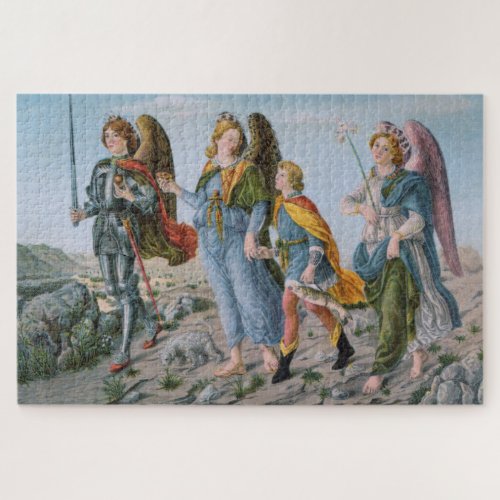Three Archangels and Tobias (M 017) Jigsaw Puzzle



Group portraits of the Archangels are comparatively rare. This painting Three Archangels and Tobias by Francesco Botticini (1446-1498), a minor master of the Early Italian Renaissance, is an exception. According to archival sources, this painting originally adorned the altar of the Confraternity of the Archangel Raphael (the “Raffia”) in the Augustinian Church of the Holy Spirit in Florence c. 1470. Confraternities were Church-sanctioned lay religious and social organizations for promoting piety and charity. Founded in 1411, the Raffia—of which Botticini himself was a member—was a youth confraternity that promoted education and the arts. + Here, St. Raphael and Tobias take center stage in a rocky, barren landscape. Both figures are richly clad. St. Raphael wears a blue robe, a red and gold brocade mantle with a green velvet lining, and sandals. His halo is white openwork. His wings are made of peacock feathers. In his right hand, he holds a small gold container of unguent made from fish entrails. He gazes down at Tobias as if about to speak guiding the youth with a light touch of his hand. Tobias strides forward with determination and a spring in his step. A blond, curly-haired youth, Tobias wears a knee-length belted blue tunic lined with white fur, a reddish cape lined in golden yellow, pinkish hose, and black boots with golden yellow cuffs. He carries a large, trussed-up fish. Scripture tells us that Tobias caught the fish in the Tigris River at the Archangel’s direction. Its various body parts were later used to cure Tobias’s father of blindness and exorcise a demon from the girl he would marry. His little gray dog, a symbol of fidelity, sniffs the ground at the travelers’ feet. The contours of the figures are precisely delineated. And, the fabrics and ornamentation are rendered with great attention to detail. + The journey of St. Raphael and Tobias was a popular subject for stand-alone paintings in 15th-century Florence. Florence was a city with a rising middle-class of prosperous merchants. And, merchants traveled. They braved shipwrecks, attacks by pirates or brigands, and other perils on the high seas and on the open road. Knowing they had an amiable, Heaven-sent patron saint like St. Raphael eased their fears on an existential level. + To the left, St. Michael heads up the column of travelers clad in contemporary 15th-century plate armor. Sword arm outstretched, he holds his weapon at the ready, ready to handle any danger. St. Michael has auburn hair, a white openwork halo, red shoes, a short red cape with a green lining, and dark wings. In his free hand, he holds an orb, a symbol of authority, or a weight, a reference to his role in the weighing of souls at the Last Judgment. + St. Gabriel brings up the rear on the right-hand side of the painting. Clad in a white gown shaded in pastel pinks, blues, and violets, and wrapped in a green mantle lined in vibrant aqua blue, St. Gabriel, Archangel of the Annunciation, carries a lily, symbol of purity. Like the others, he has an openwork halo but walks barefoot. His wings are darker shades of pink and purple. + Feast: September 29 + Image Credit (M 017): Three Archangels and Tobias, by Francesco Botticini (1446-1498), tempera on panel, 60 5/8” x 53 1/8” (154cm x 135cm), Florentine Italian, ca. 1470, Uffizi, Florence, Italy. {{PD-Art|PD-old-100}}. From an antique Stengel postcard in the designer’s private collection.


